Jordan
|
Jerash
Click on any image below to enlarge or start a slide show.  Jerash ruins Jerash ruins
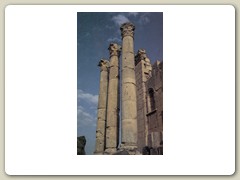 Jerash ruins Jerash ruins
 Jerash ruins Jerash ruins
 Jerash ruins Jerash ruins
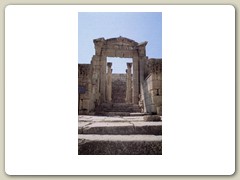 Jerash ruins Jerash ruins
 South Gate South Gate
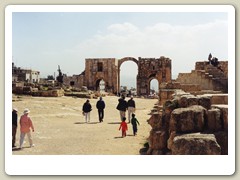 Hadrian Arch Hadrian Arch
 Surrounding landscape Surrounding landscape
 Oval Plaza Oval Plaza
 Genesius Church Genesius Church
 Genesius Church Genesius Church
 Jerash City Walls Jerash City Walls
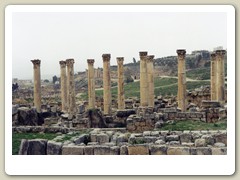 Jerash ruins Jerash ruins
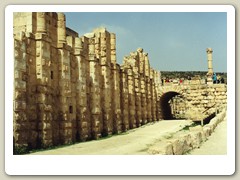 Cardo Cardo
 Cardo Cardo
 Hippodrome Hippodrome
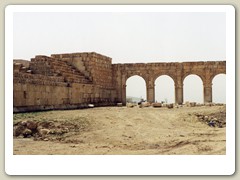 Hippodrome Hippodrome
 Hippdrome Hippdrome
 Byzantine Church Byzantine Church
 Bishop Isaiah Bishop Isaiah
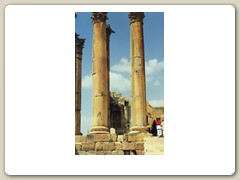 Temple of Artemis Temple of Artemis
 Temple of Artemis Temple of Artemis
 Temple of Artemis Temple of Artemis
 Temple of Artemis Temple of Artemis
 Forum Forum
 Forum Forum
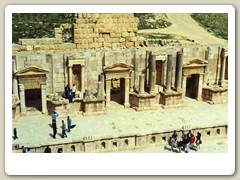 Theater Theater
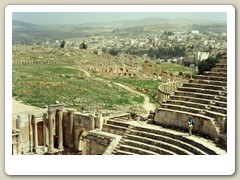 Theater Theater
 Jerash ruins Jerash ruins
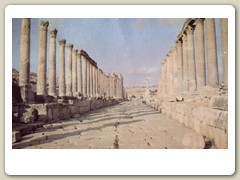 Jerash ruins Jerash ruins
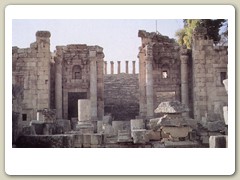 Jerash ruins Jerash ruins
 Jerash ruins Jerash ruins
 Jerash ruins Jerash ruins
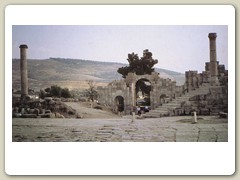 Jerash ruins Jerash ruins
 Jerash ruins Jerash ruins
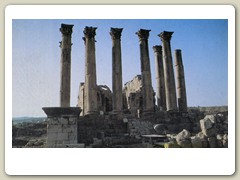 Jerash ruins Jerash ruins
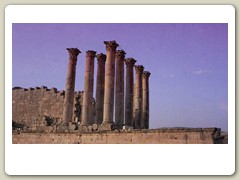 Jerash ruins Jerash ruins
 Temple of Zeus Temple of Zeus
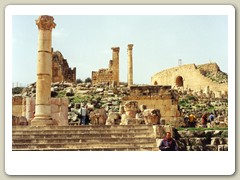 Temple of Zeus
lightbox gallery cmsby VisualLightBox.com v6.1 Temple of Zeus
lightbox gallery cmsby VisualLightBox.com v6.1
Less than 50 kilometers north of Amman, nestled in the Gilead Mountains, lies one of the best-preserved Roman provincial cities of the Decapolis, and indeed of the world. The area was populated at least since Neolithic times, or 6000 BC, but the leap from a small settlement to an important city was probably made under the rule of one of the Seleucid kings. Research points to King Antiochus IV, who ruled between 175-163 BC, as most likely responsible for transforming the place into a prominent center. Jerash became an important crossroads, a meeting place for East and West. Here, the Roman Empire encountered the Near East. Aside from its crucial role in trade, Jerash became the model of a new kind of Roman city built with a distinctly Oriental flavor. But Jerash offers visitors much more than the ruins of an impressive Roman city. Within the complex are remains of 2,500 years of settlement, from the Bronze and Iron ages and the Hellenistic, Roman, Byzantine, Umayyad and Abbasid periods, spanning from about 1600 BC through 900 AD. Most of the structures are from the first through ninth centuries AD, but the museum houses a collection that includes more ancient artifacts. In the Hellenistic period, Jerash was known as Antioch on the Chrysorhoas, or "Golden River." The little stream was no larger in those days than it is today, making the name something of a misnomer, but it has always provided a source of fresh water and made the region particularly fertile. Like so many other sites in Jordan, Jerash was lost to the world for hundreds of years. In 1806, German researcher Ulrich Jasper Seetzen "rediscovered" the city, and it has been a popular tourist destination and the site of important archeological work ever since. The Romans drew up a grand city plan for the place they called Gerasa around 50 or 60 AD. It was designed around a main north-south axis road, or Cardo Maximus, two east-west intersecting streets with a wall protecting the whole area. Over the next two centuries, the city developed rapidly and prospered. In the third century, it was elevated to the status of a colony, but it began to decline soon thereafter. South Gate and South Street The main entry to Jerash for travelers coming from Philadelphia (Amman), this gate is very similar to Hadrian's Arch a few hundred meters further south. The South Street leads from the South Gate through an area that was populated in the second century BC, when Jerash was the site of a Hellenistic city.
Hadrian's Arch Approaching from the south, the first thing a visitor sees is Hadrian's Arch. A typical Roman triumphal arch, it was built to mark the visit of Emperor Hadrian in 130 AD The designers were a bit too optimistic about Jerash's expansion; the arch lies more than 400 meters south of the city's walls, and it never became part of the city. Just north of the arch is Jerash's South Gate. A perfectly straight Roman road connects the two, which bear similar columns and floral carvings.
Oval Plaza The unusual shape of this plaza is probably explained by the Roman town planners' insistence on symmetry. If not for the 90 meter by 80 meter shape, the axes of the South Street and the Cardo would not have crossed properly. The column that stands at the center of the plaza is not ancient; the Jordanians built it recently to hold the torch of the annual Jerash Festival, an international arts and culture event held each summer in the Roman theatres. Bishop Genesius Church Mosaic floor of the Church of SS Cosmos & Damian. A floor mosaic dated 611 gives this church the distinction of being the last church built in Gerasa before the arrival of the Persians in 614. City Walls
Continually rebuilt and expanded
with Jerash's growing fortunes, the city walls were first constructed
around 60 AD. What remains today is a total of 3.5 kilometers of
three-meter thick walls surrounding an area of almost one square
kilometer. The stream flows through
the walled city. Temple of Artemis Named for the Greek goddess, the Temple of Artemis dominates Jerash. Built in the second century AD, at the height of Gerasa's prosperity, everything about the temple was lavish and extravagant — from the 100-metre staircase leading up from the Cardo to the sanctuary itself. Some scholars believe the temple was never completed. Its ruins provided the Byzantines and Umayyads with raw materials for pottery-making.
Zeus Temple In all likelihood, the hilltop Zeus Temple was built in the first or second century BC, but no archeological remains that verify the date have been unearthed. Inscriptions detailing donations by wealthy town residents tell us that the first Roman sanctuary was built in the first half of the first century AD. The temple is surrounded by three terraces called temenos, or the holy precinct. Such temenos usually encircled ancient temples in the
region.
The Forum (Agora) Reached through the Cardo, the Forum is a large public building that seems to have been the main meeting place in the second century AD. The beautiful mosaic floors of the shops that lined the Forum's entryway have been rebuffed to preserve them.
Theaters Jerash boasts three Roman theatres, the largest of which is the South Theatre, which could seat 3,000. Visitors can still see the Greek numbers on the seats, indicating that people could reserve seats in advance. The acoustics are exceptional, and the reconstructed stage - which features decorations carved from stone - is as ideal a setting for performances at the modern-day Jerash Festival as it was 2,000 years ago.
The North Theatre, which has also
undergone extensive excavation, was completed in 165 AD. Originally a
small covered Odeon with 14 rows of seats that was used for poetry
readings, plays and meetings of the city council, it underwent frequent
remodeling and modification. By the time it ceased to be used, in the
sixth century, it had been expanded to seat 1,600 people. It seems that
a major earthquake in the mid-sixth century destroyed the theatre, and
its stones were used to build many other buildings.
The Festival Theatre lies 1,500 meters north of the city's North Gate
and overlooks the Birketein ("Two Pools") Reservoir. The theatre, which
seats 1,000, seems to have been used for religious festivals, some of
which may have included risque performances by
naked women. Church of Bishop Isaiah Built by the ruler whose name it bears, this church was completed in 559 AD, and was used until the 747 earthquake which leveled much of Jerash. Built in typical Byzantine style, the church has a central nave, two flanking aisles and mosaic floors that featured geometric, floral and fauna patterns, as well as portraits. Most of the human and animal figures in the mosaics, which have been reburied since their discovery, were defaced in the eighth and ninth centuries. Byzantine Churches More than a dozen Byzantine churches have been excavated at Jerash, and others certainly remain to be "discovered." Most were built during the fifth and sixth centuries AD, and used materials taken from old Hellenistic and Roman structures. Many of the beautiful mosaic floors have been reburied to protect them, but some are on display here and in Amman. Hippodrome Measuring 245 meters by 51 meters, this facility could hold 15,000
people, making it by far the largest sports and entertainment site in
Jerash. Scholars have not been able to pinpoint its construction date;
indeed, they are unsure whether it was ever completed and
used. Located beyond Hadrian's Arch but
outside the city walls, the Hippodrome is surrounded by a
Roman-Byzantine cemetery that has many rock-cut tombs where
residents were buried. The Cardo Ancient Jerash's main thoroughfare, the Cardo, extends 800 meters north from the edge of the Oval Plaza. Its Corinthian columns date from the second century AD. At the far north extreme, the Cardo is narrower and is bordered by the Ionic colonnade that was built along the entire length in the first century AD. The Cardo, which was the focal point of the ancient city, was in itself a miracle of engineering, with an advanced sewer system running beneath its entire length. The road's large stones bear evidence of the Roman chariots that rode along it every day.
|
Copyright ©1999 by
John Walter. All
rights reserved.
The
website contents may not be copied, published or duplicated without consent.